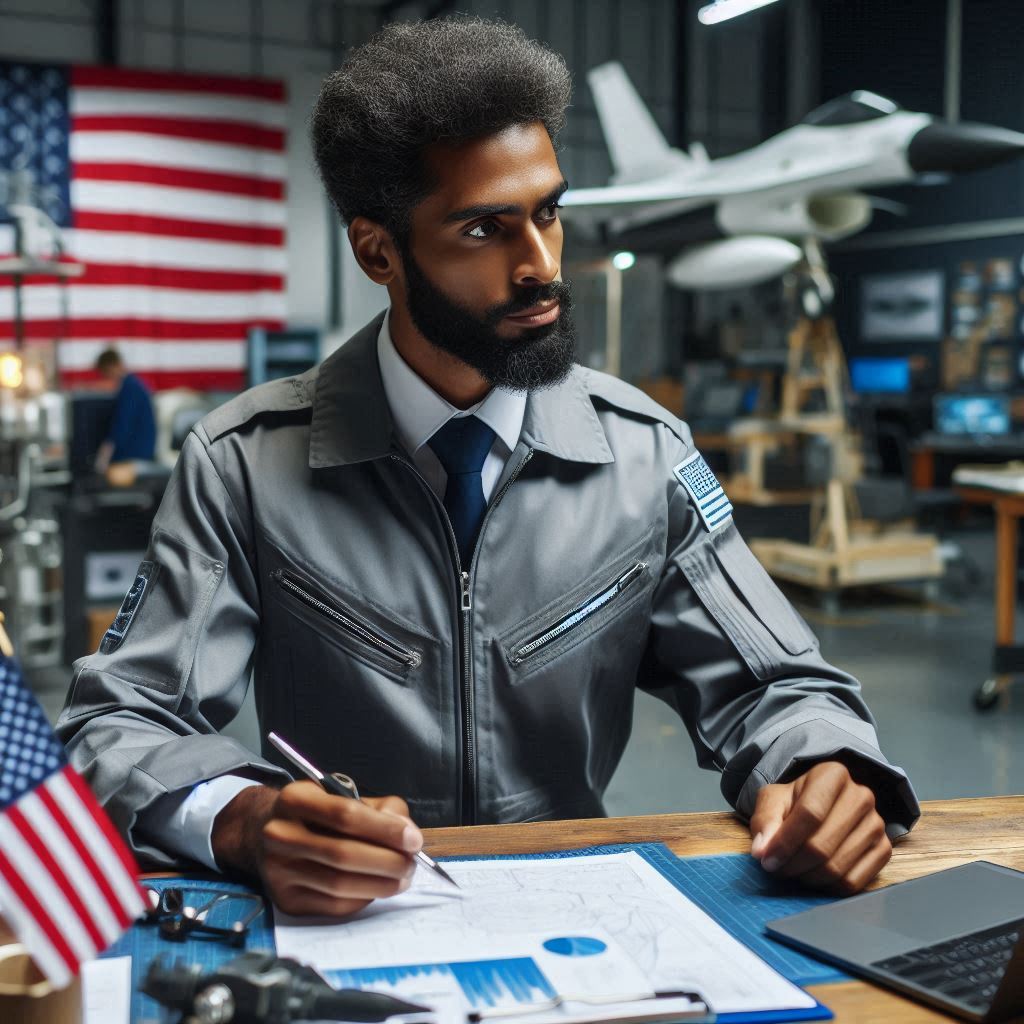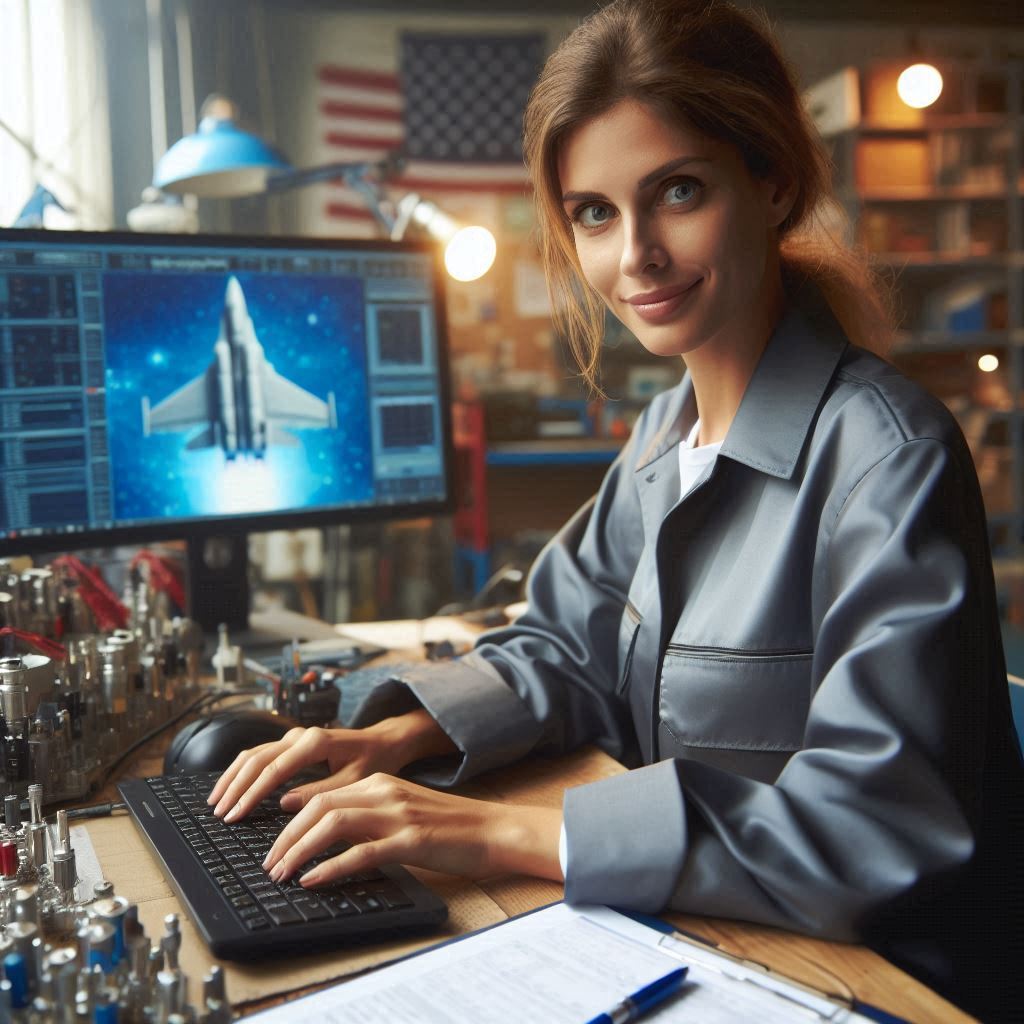Introduction
Aerospace engineers design, develop, and test aircraft and spacecraft to ensure they meet rigorous performance and safety standards.
Their work is essential in both aviation and space exploration, driving advancements that shape the future of transportation and scientific discovery.
In aviation, aerospace engineers focus on enhancing aircraft performance, efficiency, and safety, ensuring that air travel remains reliable and innovative.
In space exploration, they develop spacecraft capable of enduring extreme environments and supporting complex missions beyond Earth‘s atmosphere.
Understanding what a typical day looks like for an aerospace engineer offers valuable insights into the role’s significance.
Aerospace engineers balance multiple responsibilities, from conceptualizing new designs to conducting tests and analyzing data.
Their days often involve collaboration with cross-functional teams, problem-solving complex engineering issues, and refining prototypes.
This blog will explore the daily activities and challenges faced by aerospace engineers.
We will look at their diverse tasks, including project meetings, design reviews, and hands-on testing.
By examining a day in their professional life, we aim to highlight the critical role they play in advancing aerospace technology.
Join us as we delve into the dynamic and rewarding world of aerospace engineering.
Morning Routine
Wake Up Early
An aerospace engineer starts the day early, often before sunrise.
Rising early allows for a head start on tasks and projects.
The quiet morning hours provide a peaceful environment for preparation and focus.
This early routine helps in managing a busy schedule efficiently.
Have Breakfast and Coffee
Breakfast and coffee are crucial parts of the morning routine.
A nutritious breakfast fuels the body for a demanding day.
Coffee boosts alertness and concentration, essential for tackling complex engineering problems.
Taking time for these rituals sets a positive tone for the day.
Review Schedule for the Day
After breakfast, engineers review their schedule for the day.
They check appointments, meetings, and deadlines to plan their tasks effectively.
Reviewing the schedule helps prioritize urgent tasks and manage time.
This planning is vital for balancing multiple projects and responsibilities.
Check Emails and Messages
The next step involves checking emails and messages.
Aerospace engineers receive updates from colleagues, clients, and project teams.
Managing emails efficiently ensures that important communications are addressed promptly.
This process helps in staying organized and informed about project developments.
Morning Meetings and Project Work
After handling initial tasks, engineers attend morning meetings to discuss project updates.
These meetings include team members, project managers, and sometimes clients.
Engineers review progress, tackle challenges, and plan next steps, setting the agenda for the day‘s work.
Hands-On Work and Problem Solving
Following meetings, engineers focus on hands-on tasks.
This includes designing components, running simulations, and analyzing results.
Specialized software and tools are used for detailed work.
Problem-solving is a key aspect, addressing design issues and technical challenges.
Collaboration and Teamwork
Throughout the day, engineers collaborate with colleagues.
This involves discussing technical details, reviewing designs, and brainstorming solutions.
Effective teamwork is essential for integrating various project components and achieving successful outcomes.
Collaboration ensures that all aspects of the project align with the goals.
Afternoon Reviews and Adjustments
In the afternoon, engineers review their progress and make necessary adjustments.
They assess their work outcomes and refine designs based on feedback.
This iterative process helps in meeting project specifications and improving quality.
Wrap-Up and Preparation for the Next Day
As the day concludes, engineers wrap up their tasks and prepare for the next day.
They organize their work, update documentation, and set priorities for tomorrow.
This preparation ensures a smooth transition and continuity in project work.
Evening Reflection and Relaxation
After work, engineers take time to unwind and reflect on the day‘s accomplishments.
Engaging in relaxation activities, such as exercise or hobbies, helps recharge and maintain overall well-being.
Reflection on the day‘s work provides a balanced perspective and readiness for the next day.
Aerospace engineers have a structured and dynamic day.
From waking up early to handling breakfast, reviewing schedules, and managing communications, each step is integral.
Effective planning, problem-solving, and collaboration are key to success.
Balancing work with relaxation ensures productivity and satisfaction in their engineering careers.
Design and Analysis Work
Collaborate with Team Members
Aerospace engineers spend a significant part of their day collaborating with team members.
They work closely with engineers, designers, and project managers.
Teamwork is crucial for developing innovative solutions and achieving project goals.
Engineers frequently discuss ideas, share updates, and solve problems together.
Effective collaboration ensures that everyone is aligned and working towards common objectives.
Use Specialized Software for Modeling and Simulation
Engineers use specialized software for modeling and simulation throughout their workday.
Tools like CAD (Computer-Aided Design) and CAE (Computer-Aided Engineering) are essential for creating and analyzing designs.
Software helps in simulating how aerospace components perform under various conditions.
Engineers use these tools to visualize and test their designs before physical prototyping.
This process helps in identifying potential issues and optimizing designs.
Analyze Data and Make Design Improvements
Data analysis is a key part of an aerospace engineer’s responsibilities.
Engineers review data from simulations, tests, and experiments to assess performance.
They identify trends, detect anomalies, and evaluate results to inform design decisions.
Making design improvements based on data ensures that the final product meets performance and safety standards.
Engineers iterate on designs, incorporating feedback and refining their work to achieve optimal outcomes.
Attend Meetings to Discuss Progress and Challenges
Attending meetings is an integral part of an aerospace engineer’s day.
Meetings provide a platform to discuss project progress, address challenges, and plan next steps.
Engineers present their findings, share updates, and collaborate with stakeholders.
These discussions help in aligning the team, resolving issues, and making informed decisions.
Meetings also offer opportunities to review project timelines and adjust plans as necessary.
Daily Workflow
Throughout the day, aerospace engineers balance technical tasks with collaborative activities.
They engage in discussions, use software for simulations, and analyze data to drive improvements.
Meetings play a crucial role in maintaining communication and ensuring project alignment.
Focus on Innovation and Problem-Solving
Engineers continuously focus on innovation and problem-solving.
By collaborating with their team, using advanced software, and analyzing data, they push the boundaries of aerospace technology.
Their goal is to develop cutting-edge solutions and improve existing systems.
Project Management and Coordination
Effective project management and coordination are essential for aerospace engineers.
They ensure that tasks are completed on schedule and within budget.
Coordinating with various teams and stakeholders helps in managing resources and achieving project milestones.
A day in the life of an aerospace engineer involves collaborating with team members.
Using specialized software for modeling and simulation, and analyzing data for design improvements.
Attending meetings is crucial for discussing progress and challenges.
By integrating these activities, aerospace engineers drive innovation and ensure successful project outcomes.
Their work requires a blend of technical expertise, collaboration, and effective communication to advance aerospace technology and achieve project goals.
Transform Your Career Today
Unlock a personalized career strategy that drives real results. Get tailored advice and a roadmap designed just for you.
Start NowTesting and Prototyping
Work in Testing Labs or On-Site Facilities
Aerospace engineers often spend significant time in testing labs or on-site facilities.
These environments are crucial for validating aerospace designs and ensuring safety.
In testing labs, engineers work with sophisticated equipment to simulate real-world conditions.
On-site facilities might include test centers for aircraft, rockets, or spacecraft.
In these settings, engineers are involved in various stages of the testing process.
They collaborate with technicians and other engineers to set up tests and ensure proper procedures are followed.
Their role includes preparing test rigs, calibrating instruments, and verifying that all systems are functioning correctly.
Conduct Tests on Aircraft Components or Systems
One of the key responsibilities of aerospace engineers is to conduct tests on aircraft components or systems.
Engineers design and execute tests to evaluate the performance and safety of individual parts and entire systems.
This includes testing engines, avionics, and structural components.
For example, engineers might test an aircraft’s landing gear to ensure it can withstand the forces experienced during landing.
They may also evaluate the performance of propulsion systems under various conditions.
Each test provides critical data that informs design improvements and ensures compliance with safety standards.
Monitor Performance and Gather Data
During tests, aerospace engineers meticulously monitor performance and gather data.
They use a range of sensors and measurement tools to collect data on various parameters.
This data includes temperature, pressure, vibration, and structural stress.
Engineers analyze this data in real-time to assess how well the component or system performs under test conditions.
They look for any deviations from expected performance and identify potential issues.
Accurate data collection and analysis are essential for understanding the behavior of aerospace systems and making informed decisions.
Make Adjustments Based on Test Results
Based on the test results, aerospace engineers make necessary adjustments to improve performance and safety.
If a component or system does not meet the required specifications, engineers modify the design or adjust the testing parameters.
They may work with design teams to implement changes and retest the system to ensure it meets the required standards.
For instance, if a test reveals that a component is experiencing excessive vibration, engineers might redesign it to enhance its durability.
Adjustments can also involve tweaking software algorithms or improving manufacturing processes.
The goal is to refine the design and ensure it performs reliably in real-world conditions.
Aerospace engineers play a crucial role in ensuring the safety and performance of aerospace systems.
Their work in testing labs and on-site facilities involves conducting tests, monitoring performance, and gathering data.
Based on test results, they make adjustments to enhance designs and ensure compliance with safety standards.
By conducting thorough tests and analyzing results, aerospace engineers contribute to the development of reliable and advanced aerospace technologies.
Their efforts are vital in creating aircraft, spacecraft, and components that operate safely and efficiently.
The day-to-day tasks of aerospace engineers highlight their critical role in advancing aerospace engineering and ensuring the success of aerospace missions.
Read: Economic Indicators and Their Influence on US Architects
Problem-Solving
Technical Issues and Brainstorm Solutions
Aerospace engineers begin their problem-solving process by identifying technical issues.
These issues could arise from design flaws, performance anomalies, or operational challenges.
Engineers analyze data and test results to pinpoint the exact nature of the problem.
Once identified, they brainstorm potential solutions.
This brainstorming involves creative thinking and exploring various approaches to address the issue effectively.
Consult with Colleagues and Experts
After brainstorming, engineers consult with colleagues and experts.
Collaboration is crucial for gaining diverse perspectives and expertise.
Engineers discuss the problem and potential solutions with team members, supervisors, or subject matter experts.
This consultation helps refine ideas and develop a more comprehensive approach to solving the problem.
Conduct Research and Experiments to Find Answers
With input from colleagues and experts, engineers proceed to conduct research and experiments.
They gather relevant data, review existing literature, and test different hypotheses.
Experiments are designed to validate or invalidate potential solutions.
This research phase involves hands-on work, using specialized equipment and software to obtain accurate results.
Implement Solutions and Test Outcomes
Once a viable solution is identified, engineers implement it.
They integrate the solution into the existing design or system.
After implementation, engineers conduct thorough testing to evaluate the effectiveness of the solution.
Testing helps ensure that the solution resolves the issue and meets all performance and safety standards.
Engineers analyze the test outcomes to confirm that the problem has been resolved.
Document and Review
Following the implementation and testing of solutions, engineers document their findings and the process.
Detailed documentation is essential for record-keeping and future reference.
Engineers review the process and results to ensure that all aspects of the issue were addressed.
This review helps in identifying any further adjustments or improvements needed.
Continuous Improvement
Aerospace engineers also focus on continuous improvement.
They analyze the outcomes to identify any potential areas for enhancement.
Engineers incorporate feedback and lessons learned into future projects.
This continuous improvement mindset helps in refining processes and preventing similar issues in future work.
Identifying and solving technical issues is a critical part of an aerospace engineer’s role.
Engineers start by pinpointing problems and brainstorming solutions.
Consulting with colleagues and experts provides valuable insights.
Research and experiments are conducted to test potential solutions, which are then implemented and tested for effectiveness.
Proper documentation and review ensure thorough resolution, while continuous improvement drives future success.
Read: How US Architects Adapt to Climate Change Concerns
Documentation and Reporting
Document Design Changes and Test Results
A significant part of an aerospace engineer‘s day involves documenting design changes and test results.
Engineers meticulously record any modifications made to designs.
They also detail the outcomes of tests and simulations.
Accurate documentation is crucial for tracking progress and ensuring transparency.
This information helps in understanding design iterations and validating performance.
Showcase Your Business Today
Reach thousands of readers actively exploring professional services. Publish your business profile and grow your audience now.
Publish NowWrite Reports for Internal and External Stakeholders
Engineers regularly write reports for internal and external stakeholders.
These reports summarize design developments, test results, and project status.
Internal reports keep team members and managers informed about progress and challenges.
External reports are shared with clients, regulatory bodies, and other relevant parties.
Clear, concise, and thorough reporting is essential for effective communication and project management.
Present Findings in Meetings or Conferences
Presenting findings is a key responsibility for aerospace engineers.
They prepare and deliver presentations in meetings or conferences.
These presentations include results from tests, simulations, and research.
Engineers share insights, discuss findings, and provide updates on project progress.
Effective presentations help in gaining stakeholder approval and disseminating important information.
Ensure Compliance with Regulations and Industry Standards
Ensuring compliance with regulations and industry standards is critical in aerospace engineering.
Engineers must adhere to safety, quality, and performance standards set by regulatory bodies.
Compliance ensures that designs and products meet legal and industry requirements.
Engineers review and implement guidelines to avoid potential issues and maintain high standards.
Daily Responsibilities
Throughout the day, aerospace engineers balance technical tasks with documentation and reporting duties.
They ensure that design changes are accurately recorded and test results are documented.
Writing reports and presenting findings are integral to communicating progress and maintaining stakeholder engagement.
Focus on Accuracy and Clarity
Accuracy and clarity are essential in documenting and reporting.
Engineers must ensure that all information is precise and easily understandable.
Clear documentation and reports facilitate effective communication and support decision-making processes.
Regulatory Adherence and Quality Assurance
Adhering to regulations and maintaining quality assurance are top priorities.
Engineers must stay updated with industry standards and regulations.
They implement practices to ensure compliance and address any issues promptly.
A day in the life of an aerospace engineer involves documenting design changes, writing reports, and presenting findings.
Ensuring compliance with regulations and industry standards is a critical aspect of their role.
By balancing these responsibilities, aerospace engineers contribute to the successful development and delivery of aerospace systems.
Their work requires attention to detail, clear communication, and adherence to high standards, ensuring the safety and effectiveness of aerospace technologies.
Read: Diversity in the US Architectural Scene: A Deep Dive

Collaboration with Other Departments
As an aerospace engineer, collaboration with other departments is an essential aspect of the job.
Working with a diverse team of professionals helps ensure the success of aerospace projects and maintains efficient operations.
Working with Other Engineers, Technicians, and Project Managers
Collaborating with fellow engineers, technicians, and project managers is crucial for aerospace engineers.
Each team member brings a unique set of skills and experiences to the table, contributing to the overall success of the project.
Engineers work together to design and develop aerospace systems, analyze performance data, and troubleshoot any issues that arise during the project.
Technicians play a vital role in testing and maintaining equipment, ensuring that it meets industry standards and safety regulations.
Project managers oversee the project timeline, budget, and resources, ensuring that deadlines are met and projects stay within scope.
Working together seamlessly, these professionals can achieve remarkable results in the aerospace industry.
Coordinating with Manufacturing and Maintenance Teams
Collaboration with manufacturing and maintenance teams is essential for aerospace engineers.
Manufacturing teams are responsible for producing aircraft components and ensuring they meet quality standards.
Engineers work closely with manufacturing teams to provide design specifications and ensure that components are created according to the project’s requirements.
Maintenance teams are responsible for keeping aerospace systems in optimal working condition.
By coordinating with maintenance teams, engineers can gather valuable feedback on system performance and make necessary improvements or repairs.
This collaboration helps aerospace engineers ensure the reliability and safety of their projects.
Communicating with Suppliers and Clients
Effective communication with suppliers and clients is vital for aerospace engineers.
Suppliers provide necessary materials and components for aerospace projects, and clear communication is essential to ensure timely delivery and quality control.
Engineers must relay project requirements and specifications to suppliers accurately to prevent any delays or misunderstandings.
Additionally, maintaining strong relationships with suppliers fosters collaboration and can lead to innovative solutions and cost-effective strategies.
Engaging with clients is another critical aspect of an aerospace engineer’s role.
Understanding client needs and expectations is crucial for designing aerospace systems that align with their goals and requirements.
Clear communication throughout the project ensures client satisfaction and project success.
Participating in Cross-Functional Teams for Project Development
Aerospace engineers often participate in cross-functional teams to drive project development forward.
These teams bring together professionals from various departments to collaborate on specific project goals and objectives.
By working with professionals outside their usual scope, aerospace engineers gain fresh perspectives and insights that can enhance project outcomes.
Cross-functional teams foster creativity, innovation, and efficiency in project development, leading to high-quality results.
Collaborating with experts from diverse backgrounds allows aerospace engineers to tackle complex challenges and address project requirements comprehensively.
By leveraging each team member’s expertise, engineers can develop cutting-edge aerospace systems that meet industry standards and push the boundaries of technology.
Read: Freelance vs. Firm: Career Paths for US Architects
Professional Development
Attend Workshops, Training Sessions, and Conferences
Aerospace engineers regularly attend workshops, training sessions, and conferences.
These events provide opportunities for professional development and learning.
Workshops and training sessions offer hands-on experience with new tools and techniques.
Conferences allow engineers to hear from industry leaders and gain insights into the latest research and technologies.
Participating in these events helps engineers stay current and enhance their skills.
Stay Updated on Industry Trends and Advancements
Staying updated on industry trends and advancements is crucial for aerospace engineers.
Engineers read industry journals, follow relevant news, and participate in online forums.
Keeping abreast of technological innovations and regulatory changes ensures that their knowledge remains current.
Staying informed helps engineers incorporate the latest advancements into their projects and maintain a competitive edge.
Obtain Certifications or Licenses as Needed
Obtaining certifications or licenses is an important step for career advancement.
Engineers may pursue certifications to validate their expertise in specialized areas, such as systems engineering or project management.
Licenses, such as the Professional Engineer (PE) designation, are often required for certain roles and responsibilities.
Earning these credentials demonstrates a commitment to professional standards and enhances career prospects.
Network with Other Professionals in the Field
Networking with other professionals is a key aspect of an aerospace engineer‘s career.
Attending industry events, joining professional organizations, and participating in online communities provide valuable networking opportunities.
Engaging with peers and industry leaders helps engineers exchange ideas, seek advice, and explore new career opportunities.
Building a strong professional network can lead to collaborations, mentorship, and job referrals.
Continuing Education and Skill Development
In addition to formal events, aerospace engineers engage in ongoing education and skill development.
They may take online courses or enroll in advanced degree programs to further their knowledge.
Continuous learning is essential for adapting to new technologies and methodologies.
Engineers often seek additional training in emerging fields such as artificial intelligence or advanced materials.
Professional Growth and Career Advancement
Professional growth and career advancement are supported by staying updated, obtaining certifications, and networking.
Engineers use these opportunities to set career goals, explore new roles, and pursue leadership positions.
Professional development activities contribute to long-term career success and job satisfaction.
Aerospace engineers engage in various activities to support their professional development.
Attending workshops, training sessions, and conferences keeps them updated on industry trends and advancements.
Obtaining certifications and licenses enhances their credentials and career prospects.
Networking with other professionals provides valuable connections and opportunities.
Continuous education and skill development contribute to ongoing growth and career advancement.
These activities ensure that aerospace engineers remain at the forefront of their field and achieve long-term success.
Learn More: Essential Soft Skills for Cybersecurity Analysts
Conclusion
A day in the life of an aerospace engineer is filled with diverse and impactful tasks.
From designing cutting-edge aircraft and spacecraft to conducting rigorous tests, aerospace engineers tackle complex challenges daily.
Their work demands precision, creativity, and a deep understanding of engineering principles, making it both challenging and rewarding.
The role offers opportunities to contribute to groundbreaking innovations that shape the future of aviation and space exploration.
The satisfaction of solving intricate problems and pushing technological boundaries is a significant aspect of the job.
For those passionate about aerospace and engineering, this field presents a fulfilling career path with endless possibilities.
Aspiring aerospace engineers should pursue their passion with determination, embracing the learning and growth opportunities that come with the profession.
For readers interested in exploring aerospace engineering careers further.
We encourage you to research educational paths, industry trends, and professional opportunities.
The aerospace field is dynamic and ever-evolving, and your journey into this exciting career can start today.
[E-Books for Sale]
The Big Book of 500 High-Paying Jobs in America: Unlock Your Earning Potential
$19.99 • 500 High-Paying Jobs • 330 pages
Explore 500 high-paying jobs in America and learn how to boost your career, earn more, and achieve success!
See All 500 High-Paying Jobs of this E-Book
1001 Professions Without a Degree: High-Paying American Jobs You Can Start Now
$19.99 • 1001 Professions Without a Degree • 174 pages
Discover 1001 high-paying jobs without a degree! Unlock career tips, skills, and success strategies for just $19.99!




